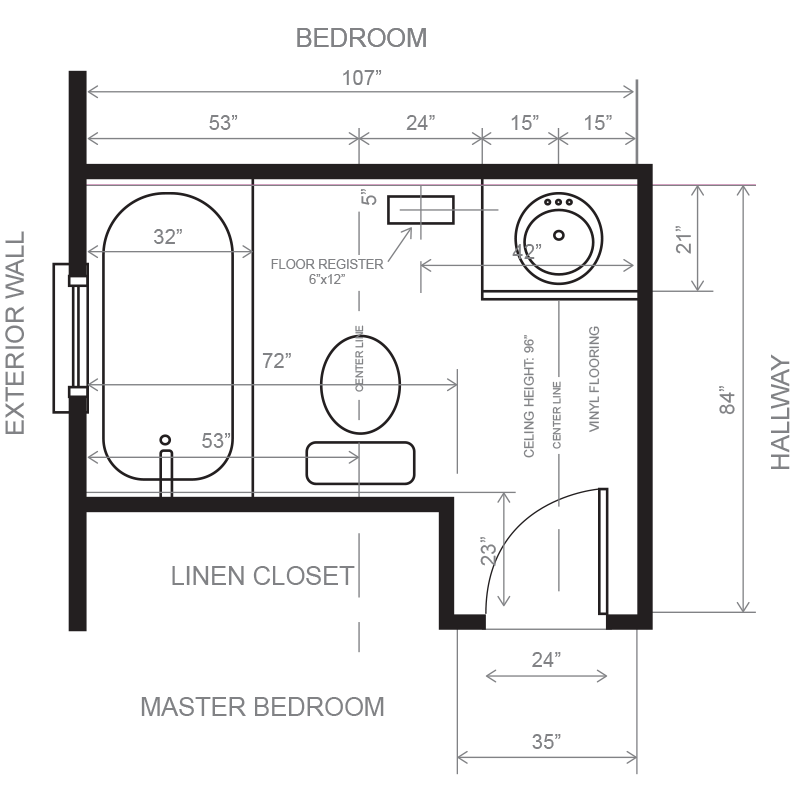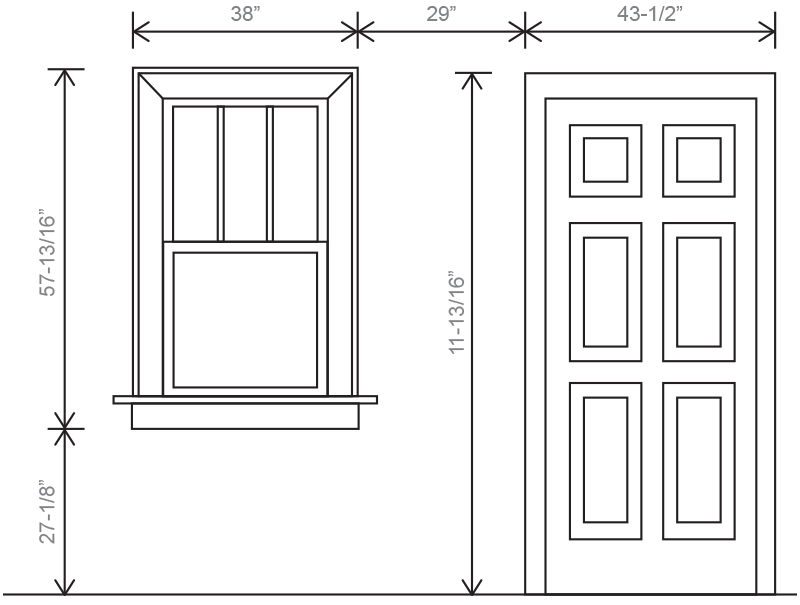Walk in Shower Floor Plan Drawings
Flooring PLAN IDEAS
Apply these sample floor plans to gather ideas about placement of elements. Whatever the size of your bathroom, keep in heed that the more than walls that contain plumbing pipes, the higher the cost tag. If budget is a concern, limit plumbing equipment to i wall; for the greatest blueprint flexibility, opt for a 3-wall layout.
Double the Comfort
Are y'all planning a main bathroom that can easily accommodate two users during the morning rush hour? Consider including a separate shower-or ameliorate yet, a walk-in shower with multiple shower heads. Install dual vanities on separate walls to raise convenience, and include the toilet in a private enclosure.
Measuring Tips
Step 1: Measure the Overall Room
Draw a diagram of your bathroom, locating all windows and doors in their judge positions. Note on the drawing the overall wall lengths of each wall. Beginning at the door opening and go along clockwise effectually the room.

Notes:
- All of your measurements should be in inches. For case, if you mensurate a wall that is ten feet, write it as 120 inches - a quotation marking (") denotes inches.
- For doorways with hinged doors, draw the door according to which mode the door swings.
- If you are replacing the cabinets, do include current cabinets or furniture such as pedestals, commodes or linen cabinets in your measurements (width x summit x depth). Nonetheless, take the measurements of any furniture you want to include in your new bathroom. Take photographs of these items. Their placement in the new bathroom is function of the blueprint procedure.
- Do indicate the precise location of the center-line of the electric current toilet, bidet, sink or vanity, and bathtub and/or shower. In the shower, measure the center of the drain from the two closest 90° walls. Bear witness the location of the shower arm and head. If your toilet is wall-mounted, write "wall-mounted" next to the toilet.
Stride 2: Label and Measure Doors and Windows
- Beginning at the superlative left comer of your drawing measure to the first window, door, or wall. Continue clockwise around the room until each wall, window and door has been measured. Remember, all measurements are in inches.
- Showtime at the elevation left of your drawing, label the windows 'Window #1 ", "Window #2", etc. in a clockwise order ...
- Again, start at the peak left of your drawing, label the doors "Door #ane ", "Door #2", etc. in a clockwise gild.
- Next to each wall, write the proper name of the adjacent room. If the wall is an "outside wall" write "exterior wall." If the room is a candidate for expanding the bath, also measure that room.
- As shown in Diagram ii, measure from the flooring to the bottom of each window and also measure the overall window height.
Notes: When measuring doors and windows the trim is considered office of the door or window. Measure from the outside of the trim on one side to the exterior of the trim on the other side, and then from the outside of the trim to the middle of the window or door.
- Using a table like Diagram 3, record the measurements for all windows. Exist sure that each window is accurately labeled.
- Note if the home is a condo or single family. If condo, what floor? Also, what is the maximum sizes that the elevator will accommodate. Single Family, note if located on the st 1 floor, second floor, or lower level.
- Note on the drawing the accessibility to the infinite and take photos. For case, the room may allow for a 72" tub, simply the tub is not able to make the tum in the hallway to the bathroom.
- Note space every bit: Master Bathroom, Hall/Guest Bath, Jack & Jill Bathroom, Powder Room

Stride iii: Place and Measure Unmovable Obstructions
- Depict boxes in your diagram to bear witness the approximate location of any obstructions such equally radiators, vents, pipes, exposed plumbing, smoke detectors, primal vac., etc. that you either cannot motion or do not want moved. Characterization the object what it is: i.e. "radiator", "pipe", etc.
- Measure the obstacle and record the width, meridian, and depth of the obstruction on obstruction reaches the ceiling, omit the height measurement. If the obstruction is non in contact with the flooring, measure from the floor to the bottom of the obstruction. Measure the distance of the object from the nearest two 90° walls.
- Measure from the nearest wall to the nearest edge of the obstacle. Measure from the point on the wall that is nearest the obstacle to the point on the obstruction nearest the wall. Mensurate from the second closest wall to the nearest betoken of the obstruction. Notation these measurements on your drawing.
- In construction dimensions of an object are ever given in the same format: width beyond the front, so height, and so depth, so the dimension 32"x54"x14" is presumed to mean 32"w 10 54"h 10 14"d unless otherwise indicated.
Pace 4: Measure the Height of the Ceiling
Mensurate the ceiling height and write it in the center of your drawing. Sometimes, especially with older homes, information technology is a good idea to take measurements in a few different areas of the bathroom. Ceiling heights, even in the same room, can sometimes vary past as much as several inches. If it varies, write down both the depression and loftier measurements.
Step 5: Cheque your Measurements
Bank check your measurements. If your room is rectangular add upward the measurements of the parallel walls and make sure they match (or are at least very close). For example, in our sample cartoon, you would take the overall measurements of the top wall and add them together. Then do the same with the lesser wall. Once you have added each wall measurements bank check the totals to see if they match.
Source: https://www.henrykitchenandbath.com/bathroom-floor-plans.html
Post a Comment for "Walk in Shower Floor Plan Drawings"